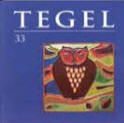 bevat artikelen over de volgende onderwerpen:
bevat artikelen over de volgende onderwerpen:
De wederzijdse invloed van China en Nederland op tegels
Trudy Laméris-Essers - page 4
In 2004 the Nederlands Tegelmuseum (Dutch Tile Museum) acquired a collection of 26 tiles, both Dutch delftware and Chinese. The author examines the symbolic meaning of the Chinese designs on the two types of tiles in this collection, and on Chinese porcelain plates. When the Dutch tiles were made, none of this symbolism was understood in the Western world. One of the Dutch tiles depicts an artemisia leaf, an ancient symbol of good fortune. The tassel-like object behind it, the significance of which was not understood, refers to the fact that Buddhist monks, who avoid killing living creatures, use a fly whisk to sweep insects out of their path.
Besides visual symbols, auditory ones occur, too. The same Chinese word, pronounced with a different tone, can have an entirely different meaning. Porcelain plates often show a picture within the outline of a maple leaf, ‘feng’ in Chinese. Pronounced in a different tone this word means ‘senior position’. Presenting somebody with one of these plates implied, at the same time, a wish for their promotion.
A combination of symbols produces a new symbol. A Chinese tile (ill. 8) depicts a cherry tree, which blossoms in winter. On its own this would symbolise winter, but the combination of cherry tree with swallows symbolises the coming of spring.
Prent en tegel
Arend Jan Gierveld - page 10
The depiction of women in regional attire on two diamond border tiles from the first decades of the seventeenth century - there was no nation-wide fashion as yet - derives from woodcuts in a book that aimed to provide a survey of how people dressed in different parts of the world. Published in 1601 by Zacharias Heyns, the book attempted to mirror the latest fashions. The reader is shown women in various costumes, among them a young woman in Antwerp and a farmer’s wife in Waterland (just north of Amsterdam) in their Sunday best. The accompanying verses summarise the principal features of the costumes. The influence of this publication by Heyns can also be traced in the decorative borders of the cartographic work of Claes Jansz. Visscher. The farmer’s wife in Waterland reappears as a milkmaid on the widely known majolica plates of about 1630.
Bijbeltegels in een Zaanse smuiger: een typologische analyse.
Minne Iedes Nieuwhof en Joop W. van der Werf - page 14
On an eighteenth-century smuiger (smoke hood) at an orphanage in Krommenie, province of Noord-Holland, almost 100 of the original 400-plus purple bible tiles with ox-head corner motifs still remained when renovation started in 1998. Details of the ox-head motifs indicate that the majority fall into three categories of bible tiles made in Amsterdam in the second half of the eighteenth century. The ox-head motifs on some of the other tiles are quite different and are not recorded in Bijbeltegels (Jan Pluis, 1994). In many cases the same sponsen (pricked stencils) were used for these tiles as for some of the Amsterdam tiles and the style in which the subjects were depicted is similar as well. Therefore the authors conclude that these tiles, too, were made in Amsterdam.
Aalmis in Istanbul: de Nederlandse tegels van de Surp Krikor Lusavoriç Kerk
Hans Theunissen en Zeynep Tiskaya - page 19
The history of the export of Dutch tiles to other European countries has been extensively recorded in the literature. Little is known, however, about Dutch tiles in the Islamic world. The present article focuses on Dutch tiles in the Surp Krikor Lusavoriç Church in Istanbul. This Armenian church was decorated in the eighteenth century with tiles from various countries, including Holland. These eighteenth century Dutch tiles probably originated at Jan Aalmis’ tile factory and include such well-known, mass-produced tiles as ‘frit-illaries’ and ‘bouquet’. The church has in its storage a few more tiles, four of which are not mentioned in the literature and appear to be unique. Three of these four tiles bear the factory name on the back (J. Aalmis, Rotterdam), and two of them also the design number.
Een menutegel
Frans H. Landzaat - page 28
Illustration 1 shows a menu tile. It was made by Gebr. Ravesteijn tile factory in Utrecht, at the request of Hendrik Albertus Lorentz (1871-1944), on the occasion of the dinner to celebrate receiving his degree of Doctor of Laws on 11 July 1900. Lorentz went on various expeditions to carry out research in unexplored areas of Dutch New Guinea (ill. 2). He subsequently pursued a career in the diplomatic service.
Streekdrachttegels
Bert-Jan Baas - page 30
Towards the end of the nineteenth century pictures of people in local costume became fashionable. Tiles depicting this type of subject, so-called ‘streekdrachttegels’ (regional costume tiles), were produced by a host of Dutch potteries, including Rozenburg in The Hague, Plateelbakkerij Zuid-Holland in Gouda, Potterij Rembrandt in Utrecht/Nijmegen, Plateelbakkerij Delft in Hilversum, Porceleinfabriek De Kroon in Noordwijk.
The designs were often derived from prints by the Belgian artist Henri Cassiers (1858-1944). Occasionally the works of painters, such as those of the Hague School, served as models. Regional costume tiles are usually datable to the first decade of the twentieth century, though the Goedewaagen factory in Gouda was still producing this type of tile in the 1930s and 1950s.
Het dierenalfabet op tegels voor De Hartenberg
Maarten L.H. van Veen - page 38
In 1969 Willem Lenssinck of the Westraven tile factory in Utrecht made 24 cloisonné tiles depicting animals. They were intended for 24 residential pavilions at De Hartenberg, a home for the mentally handicapped at Ede, the Netherlands. In the end only twelve pavilions were built. The initial letters of the names of the animals depicted on the tiles formed the complete alphabet, except for Q and X: Antelope, Beaver, Cavy (guinea pig) etc. (ill. 1). A tile was placed beside each pavilion door to indicate its name (ill. 2). From 1995 new buildings began to replace the pavilions. Their tiles, together with the twelve tiles not used in 1969, were donated to the Nederlands Tegelmuseum (Dutch Tile Museum) in Otterlo.
Inquiries among the people employed in the art department at Westraven around 1969 have failed to reveal beyond any doubt the identity of the artist who designed these tiles in 1968 or 1969.
Discussiedossier: Antwerpse tegelproductie 1570-1630
Arend Jan Gierveld - page 47
In this article the author gives a reaction on the article on the same subject published in Tegel 32. Jan Heyndricks was named a 'majolicabakker' although in Tegel 31 the author had referenced an Dordrecht archive document in which Jan Heyndricks was named 'pottenbakker'. Secondly the author questions the number of 'majolicabakkers' that were active in Antwerp in the period 1570-1630. In the Netherlands, in the first quarter of the 17th century, a lot of majolicabakkers, that were registered as such, were in fact knights.





